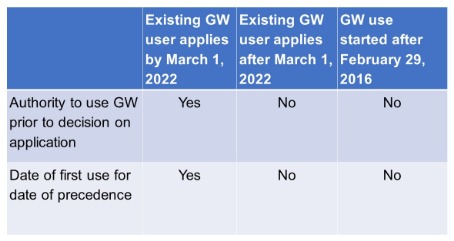May 12, 2020

This blog provides insight into the licensing of non-domestic (i.e., non-household) groundwater uses that existed when BC’s Water Sustainability Act (WSA) came into effect, insight gained while working in government (drafting and implementing the WSA and regulations).
Our hope is that the reader might better understand how the licensing requirements for existing non-domestic groundwater use came to be to encourage users to apply before the transition period ends on March 1, 2022.
To be clear, domestic (household) groundwater use does not require licensing.
What is the transitioning of existing groundwater use?
When the WSA came into effect in 2016 it allowed for a transition period for licensing "existing” non-domestic groundwater use to be given special treatment. "Existing” non-domestic groundwater use is use that began prior to the WSA coming into effect (February 29, 2016).
If an application is submitted for existing non-domestic groundwater use during this transition period, the user would benefit as follows:
● the groundwater use will be allowed to continue while the license application is being considered, and
● the date of precedence (seniority) for the use will be recognized in a licence based on the date the existing user started using groundwater (date of first use).
Applications for "existing” non-domestic groundwater submitted after the transition period ends will be treated like applications for new groundwater use (see table on the left).
This means that:
● use of the groundwater will not be authorized until the licence decision is made, and use of the water must stop at the end of the transition period and cannot resume until the licence application is processed and the water right is granted;
● impacts on environmental flow needs and on other, more senior groundwater users must be considered in the licensing decision - for larger groundwater uses, this often requires a professional assessment that would typically cost over ten thousand dollars;
● in areas where water supply limits are being reached (e.g., the dry southern interior, the east coast of Vancouver Island and Gulf Islands, the Lower Mainland), the decision maker may well decide not to even issue any further licences; and,
● if a licence is issued, the priority date for the water licence will generally be the date of the application because the date of first use will no longer be considered.
Reasoning behind transitioning
During the development of the WSA, there was much discussion around how existing groundwater use should be treated:
● What should the date of precedence be for the existing use?
● What if that existing use is causing or exacerbating problems?
Date of precedence based on date of first use
A key question was whether the date of precedence for existing groundwater uses should be the date of application (normal practice for new water use) or the date of first use. A compelling argument for the date of first use was that licensing was not ever an option for groundwater users and existing groundwater use should not be put “at the back of the line” just because the government did not license groundwater use until now. In BC, where hydraulic connection between groundwater and surface water is common, a date of precedence based on the application date (i.e., post 2016) would put existing groundwater users at a major disadvantage even though they had been beneficially using their water for years earlier than more recently licensed users using water from a hydraulically connected stream.
What if some existing uses are causing problems?
Another key question was what to do about existing groundwater use known to be causing stress on the water supply. One perspective was that the impact of existing groundwater uses, especially uses that had been on-going for decades, should already be apparent. If existing groundwater use is to be brought into the licensing scheme, any impacts could practically be managed through the terms and conditions in the licence and the general authority of the decision maker to take action when and where necessary.
Is transitioning really grandfathering?
Strictly speaking, no. The decision maker still has to make a decision to issue a license or not. The possibility of a “no” has made some users nervous and hesitant to apply. It doesn’t help that the government is silent throughout the process and the time taken to make a decision takes so long (in many cases over a year or more).
However, “transitioning” means changing from one state (unlicensed) to another (licensed). The special treatment that the government offers over the transition period includes:
● Waiving the application fee for existing groundwater users;
● Generally not requiring a professional assessment;
● Considering environmental flow needs only where necessary; and,
● Allowing use to continue while the application is being considered.
This should all signal that issuing a licence for existing groundwater use is the rule rather than the exception.
Deadline for Transitioning
The benefits of being an existing groundwater user (i.e., consideration of prior use and allowed continued use of water during the adjudication of the application) will end by March 1, 2022. The implications of that deadline to existing non-domestic groundwater users are significant and need to be fully appreciated - the use of the land and business being carried out on it depends on legal access to water.
If you believe this information is useful to your neighbour, friend, or client, please share it with them.
This post was co-written by M. Wei and D. Forsyth (former groundwater and water policy staff, respectively with the BC Ministry of Environment and Climate Change Strategy). Thanks to C. Pinches for her input on the draft of this post.